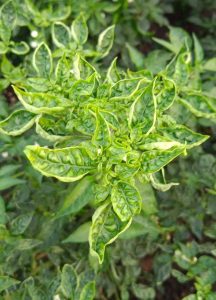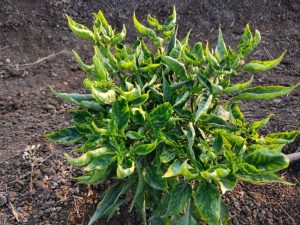Chilli is one of the most important vegetable crops in India, both for domestic consumption and for export. However, chilli plants are vulnerable to a range of viral diseases that can significantly impact crop yield and quality. These viral diseases can be spread through infected plant material or by insect vectors like thrips, aphids and whitefly. Plants are most susceptible to viral diseases during early growth stages of the crop. Therefore, effective management of these diseases is crucial to ensure a successful harvest.
Viral Diseases Affecting Chilli Crop
1. Chilli Leaf Curl Disease
This disease’s epidemics is most common during March to June in Southern India and June to October in Northern India.
Caused by: Chilli leaf curl virus (Begomovirus)
Vector: Whitefly
Symptoms

- Upward or inward curling and crinkling of leaves in affected plants
- Shortening of internodes
- Reduction in the size and number of leaves in young plants giving ‘bushy appearance’
- Affected leaves may turn yellow, especially at the margins or in between the veins
- Thickening of veins in leaves
- Development of leaf enations (small, wart-like growths on the leaf surface)
- Reduced flowering and fruiting
- Affected plants produce smaller and deformed fruits
- In severe cases, the affected plants show stunted growth.

Affected plants show bushy appearance
2. Chilli Mosaic Disease
Caused by: Cucumber Mosaic Virus
Vector: Aphids
Mode of spread: The disease may also spread through mechanical contact and through seeds.
Symptoms
- Initially, chlorotic lesions appear on the leaves followed by mosaic pattern of light and dark green areas, giving them a distorted appearance
- Leaves of infected plants may become distorted, with puckering or twisting of the leaf margins
- Infected plants exhibit stunted growth and produce less fruits \Infected plants produce hard and brittle fruits, full of seeds
- In some cases, presence of yellow streaks can also be seen on the fruits.
3. Chilli Necrosis Disease
Caused by: Groundnut bud necrosis virus (GBNV), Tomato spotted wilt virus (TSWV), Watermelon bud necrosis virus (WBNV), Capsicum Chlorosis Virus (CaCV)
Vector: Thrips
Mode of spread: Through mechanical contact
Symptoms
- Yellowish spots or patches appear on the leaves with chlorotic concentric rings
- Younger leaves show bronzing symptom, followed by appearance of necrotic ring spot
- The growing tips of infected plants may develop necrotic spots, leading to the death of the entire twig
- Severe stunting and cessation of plant growth may also occur
- Infected plants may produce deformed and unevenly ripe fruits in the early stages of infection
- Fruits formed after late-stage infections may show concentric rings with chlorotic spots.
4. Chilli Mild Mottle and Mosaic Disease
Caused by: Pepper mild mottle virus and Tobacco mosaic virus
Vector: Any sucking pests (Thrips / Aphids / Whitefly)
Mode of Spread: Seed borne, Transmitted through sap
Symptoms
- Leaves may show light and dark green areas, giving them a mottled appearance
- Interveinal chlorosis can be seen
- Leaves may be distorted or crumpled
- Reduced number of fruits produced
- Produced fruits may also be mottled and distorted.
Preventive Measures
- Use certified virus-free seeds for sowing
- Maintain field sanitation
- Grow 2 rows of border crops with maize, jowar or bajra 15 days prior to transplanting seedlings
- Crop rotation with non-host crops like legumes, cereals or brassicas for atleast 2 years
- Grow virus resistant varieties
- Rogue out the infected plants and weed hosts from the field
Management of Chilli Viral Diseases
There is no specific cure or control measure for viral diseases in plants. But controlling the vector that spreads the viruses, applying micronutrients to strengthen the plant’s immune system, and implementing above-mentioned preventive strategies can be effective in managing chilli viral diseases. The supplement of plant stimulants or micronutrients may help the plants to develop some kind of inhibition towards virus attack and also bind the active viruses in the plant sap, so that the multiplication and further damage may be reduced.
| Products | Technical content | Dosage |
| Plant Stimulants | ||
| Geolife No Virus | Combination of rare herbs | 3 – 5 ml/lit water |
| V-Bind | Plant Extracts | 2 – 3 ml/lit water |
| Perfekt Crop Health Enhancer | Herbal formulation | 1 ml/lit water |
| Vedagna Viru | plant extracts fortified with several phyto-elicitors and amino acids | 2.5 gm/lit water |
| Micronutrients | ||
| Geolife Tabsil | Ortho silicic acid (12 %) | 1 gm/lit water |
| Multiplex Magnum Mn | Manganese 12% | 0.5 gm/lit water |
| Sambrama Micronutrient Fertilizer | Major nutrients – N, P, K; secondary nutrients–Ca, Mg, S and micronutrients like Zn, Mn, Fe, Cu, B & Mo | 1 tablet/15 lit water |
| Multiplex General Liquid | Micronutrients | 2.5 ml/lit water |
Products to control Sucking Pests (Vectors)
| Products | Technical content | Dosage |
| Mechanical | ||
| Yellow Sticky Trap | Trap | 4 – 6/acre |
| Biological | ||
| Neem 0.15% | Azadiractin 1500 PPM (0.15%) EC | 2 – 2.5 ml/lit water |
| Chemical | ||
| Anant Insecticide | Thiamethoxam 25% WG | 0.3 – 0.5 gm/lit water |
| Pegasus Insecticide | Diafenthiuron 50% WP | 1 gm/lit water |
| Confidor Super Insecticide | Imidacloprid 30.5% SC | 0.3 ml/lit water |
| Movento Insecticide | Spirotetramat 15.31% OD | 2 ml/lit water |
| Marshal Insecticide | Carbosulfan 25% EC | 2 ml/lit water |
NOTE:
- Combinations of a plant based active compound, micronutrient and pesticides can be effective to manage both sucking pests as well as develop resistance of plants against viral diseases. (For instance, Geolife No Virus + Tabsil + Neem oil + Anant Insecticide).
- Check the product’s description to know the right time and frequency of application.
Explore the ultimate guide to chilli cultivation for expert tips and steps to a successful harvest.Click here





